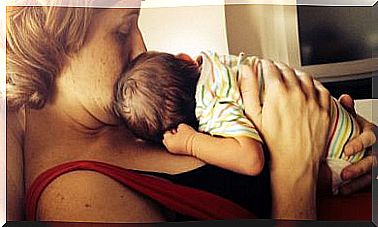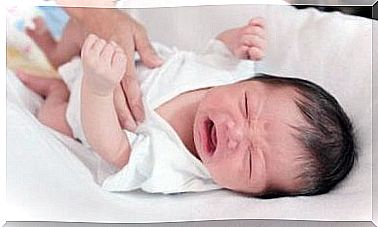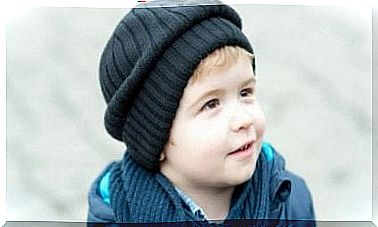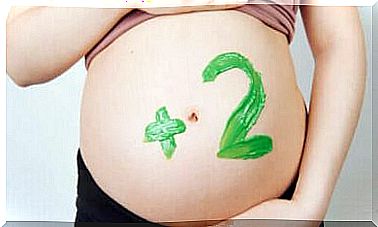Preventing Illnesses By Breastfeeding

At the moment, no one doubts that breast milk is the best food a mother can give to her baby. It has several benefits for both the mother and the child. But did you know that there are also many diseases that you can prevent by breastfeeding?
Without arguing about whether a woman breastfeeds or not, because every woman gets to choose whether to do it and not feel guilty about her choice, the truth is that many scientific studies support the positive results of breast milk.
The World Health Organization claims that children should be exclusively breastfed for the first 6 months of life. If possible, this period can be extended to 2 years, in combination with other food.
What is breast milk made of?
It may surprise you, but breast milk is a living liquid. It can adapt to the nutritional needs and immunological requirements of the baby as it grows.
In the first 3 or 4 days after delivery, the mother produces colostrum. This is a thick, yellow liquid that is rich in nutrients. Then, between 15 and 30 days after birth, the mother produces ‘ripe milk’.
As amazing as it is, the content of breast milk is still not fully known. Not only does it vary by woman, but it can also vary by breast and depending on how much the baby is drinking and the different stages of breastfeeding.
However, there are a few characteristics that we do know:
- It contains the carbohydrates, proteins and fats that the baby needs.
- It provides the proteins, minerals (iron, calcium, zinc, sodium), vitamins (E, A, D, K) and the hormones that the baby needs.
- Breast milk contains antibodies that prevent the baby from getting sick. For example, it contains immunoglobulins, which protect the baby’s mucous membrane; lymphocytes and macrophages, which serve as protection from the environment; lactoferrin, which contributes to the absorption of iron and also protects the baby against bacteria.
Looking at this data, it’s not surprising that you can help prevent diseases by breastfeeding. But what specific diseases are involved?

Some diseases you can help prevent by breastfeeding
While breastfeeding, the baby receives nutrients that help him avoid certain diseases, such as:
- Antioxidants and quinones found in colostrum protect against hemorrhagic disease.
- Immunoglobulins protect the digestive system, even undeveloped, and help prevent viruses, bacteria and parasites such as E coli, rotavirus, salmonella, pneumococcus, staphylococcus, etc.
- Lowers the risk of respiratory infections such as bronchitis or pneumonia as it helps the lungs develop.
- Would help reduce the risk of SIDS.
- Prevents allergies.
- Protects against skin disorders.
- Decreases the risk of conjunctivitis.
- Helps prevent ear infections.
- Is effective against both diarrhea and constipation.
- Improves neural connections and brain development.
- Lowers the risk of anemia.
- Improves visibility.
Besides the things mentioned above, the function of breastfeeding is not only to protect the baby in the first years of his life. It also has the ability to protect the baby from adult diseases, such as diabetes, asthma, arteriosclerosis, heart attacks, etc.
Benefits for the mother
Besides that breastfeeding protects the baby against diseases, this way of feeding also has many benefits for the mother.
During this period, a bond develops between the mother and the child that is far stronger than we could ever imagine. It is a special and inexplicable connection.
In addition, the brain produces more oxytocin thanks to physical contact. This has positive consequences for the mother, because it helps to reduce the risk of postpartum depression.
Because of the increase in production of this hormone, she will become more confident. The cortisol level (the stress hormone) also decreases, making her less anxious, having less pain and increasing her milk production.
Also, oxytocin activates all the hormones she needs for her own digestion when she’s breastfeeding. The function of the stomach and intestines improves to such an extent that it allows for a more efficient use of all the food that the mother ingests.
After delivery, breastfeeding also causes the uterus to contract and return to its normal size more quickly .
Breastfeeding also reduces the risk of breast, ovarian and cervical cancer. Finally, breastfeeding can also help a mother regain her original figure faster.

Enjoy even more benefits of breastfeeding
It is clear that breastfeeding can prevent many diseases and has many benefits for the mother and her baby. However, the benefits go further than just health. We can mention more aspects, such as, for example, the constant presence of food for the baby.
This way we also know that the milk is always at the right temperature and ready for use. You don’t need anything to transport it.
And if all this is not enough, it is also 100% hygienic and safe for the baby. Without a doubt, breastfeeding is the ideal food for babies.








